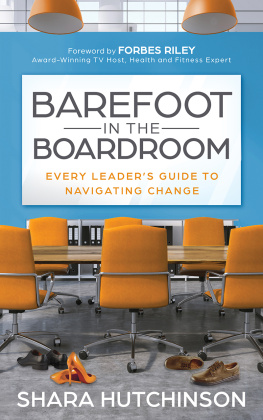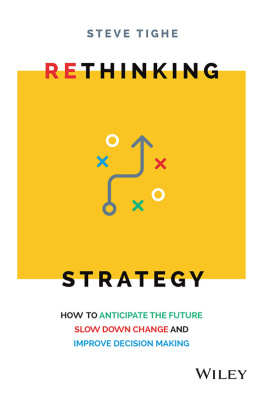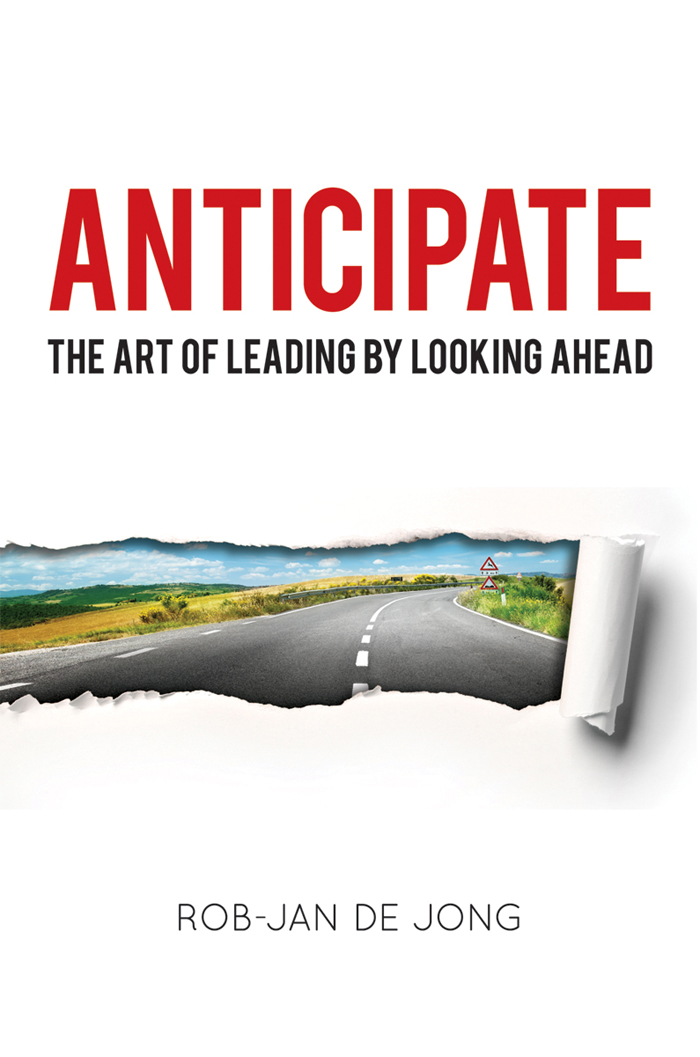ANTICIPATE
ANTICIPATE
THE ART OF LEADING
BY LOOKING AHEAD
ROB-JAN DE JONG

AMERICAN MANAGEMENT ASSOCIATION
New York Atlanta Brussels Chicago Mexico City SanFrancisco
Shanghai Tokyo Toronto Washington, D. C.
Bulk discounts available. For details visit: www.amacombooks.org/go/specialsales
Or contact special sales: Phone: 800-250-5308 E-mail: specialsls@amanet.org;
View all the AMACOM titles at: www.amacombooks.org
American Management Association: www.amanet.org
This publication is designed to provide accurate and authoritative information in regard to the subject matter covered. It is sold with the understanding that the publisher is not engaged in rendering legal, accounting, or other professional service. If legal advice or other expert assistance is required, the services of a competent professional person should be sought.
LIBRARY OF CONGRESS CATALOGING-IN-PUBLICATION DATA
De Jong, Rob-Jan.
Anticipate : the art of leading by looking ahead / Rob-Jan de Jong.
pages cm
Includes index.
ISBN 978-0-8144-4907-3 ISBN 0-8144-4907-7 1. Leadership. 2. Creative ability in business.
3. Strategic planning. I. Title.
HD57.7.D4 2015
658.4092--dc23 2014024651
2015 Rob-Jan de Jong.
All rights reserved.
Printed in the United States of America.
This publication may not be reproduced, stored in a retrieval system, or transmitted in whole or in part, in any form or by any means, electronic, mechanical, photocopying, recording, or otherwise, without the prior written permission of AMACOM, a division of American Management Association, 1601 Broadway, New York, NY 10019.
The scanning, uploading, or distribution of this book via the Internet or any other means without the express permission of the publisher is illegal and punishable by law. Please purchase only authorized electronic editions of this work and do not participate in or encourage piracy of copyrighted materials, electronically or otherwise. Your support of the authors rights is appreciated.
About AMA
American Management Association (www.amanet.org) is a world leader in talent development, advancing the skills of individuals to drive business success. Our mission is to support the goals of individuals and organizations through a complete range of products and services, including classroom and virtual seminars, webcasts, webinars, podcasts, conferences, corporate and government solutions, business books, and research. AMAs approach to improving performance combines experiential learninglearning through doingwith opportunities for ongoing professional growth at every step of ones career journey.
Printing number
10 9 8 7 6 5 4 3 2 1
Dedicated to my father, whose life stance continues to inspire me
I wish you were still here to witness.
Contents
Preface
When I graduated from high school some thirty years ago, the schools principalwho had also been our draconian German class teachersubtly criticized my attitude of continuous challenge during the diploma ceremony. After putting in a few nice words for my parents, he mentioned that he would remember me as a vigilant student who was always willing to point out a different perspective. I think he was just trying to tell me that I had behaved like a wiseass know-it-all more often than he had liked.
I was raised in Europe (the Netherlands) and went through high school in the early eighties, amid vivid political debate about the pros and cons of capitalism vs. those of socialism, the madness of the nuclear arms race both sides had entered, Ronald Reagans Star Wars protection program, the birth of Polands Solidarity union and many other Cold Warrelated West vs. East themes. The schools principal was known to uphold right-of-center opinions, and I would oppose him with leftish arguments. But when we moved to our next class and found ourselves discussing the same themes with a left-wing-oriented teacher, Id just as easily morph into the right-of-center rationale. Just for arguments sake.
This was probably more than just a teenager trying to make sense of the world around him. I was fascinated by the debate, and my curiosity about the other side of an argumentany argumentwithheld me from committing to one worldview. The issues seemed too complex for that. The curiosity remained; later in life, I transformed it into an interest in exploring and challenging what is seemingly taken for granted (keeping the annoyance factor in check).
This book emerged from that same fascination with questioning what might seem simple and mundane, clear and understood, but on second thought isnt that easy at all. As we progress to discover the art of anticipating the future, well go in depth, exploring the seemingly straightforward concept called vision, a word often and readily used in the domain of business and political leadership. Some scholars call it the hallmark of leadership, others list it among the three or four central themes, and yet others put it on a different pedestalyoull rarely find anyone who does not deem it an important leadership theme. In real life, the importance of vision is easily acknowledged as well. In business, for example, we frequently find people criticizing their superiors for their lack of it.
But then, when it comes to developing our own vision, its suddenly no longer duck soup. We wonder if its really that important, and even if we are convinced, its not clear to us how we should actually go about foretasting the future. It seems to come naturally to the larger-than-life kind of leaders who seemingly effortlessly inspire with a compelling big-picture story. But for us mortal souls, artfully looking ahead, anticipating the future, and inspiring others with a gripping vision does not come easy. Nor does it top our to-do list of important matters to work on in terms of growing our leadership persona.
I find such contradictions fascinating. Theoretically top of the list, in practice bottom of the list. It got me wondering why we struggle with this issue. How do we concretely engage with the future? Were all fascinated by it; we all have dreams and ambitions. We all make plans, and most of us like to be part of something thats fascinating and energizing. So engaging with the future, and the things it might have in store for us, should by definition be of interest to us. But where does it disconnect? Or better, what could we do to make it better connect?
To get a deeper understanding of how this process of engagement with the future works (or doesnt work) with leaders and aspiring leaders, I ran a survey several years ago to test this phenomenon. The survey used a four-level scale that indicated the degree of someones future engagement. I gathered answers from 210 people from a wide range of different industries.
When I asked people what they do, concretely, to stay in touch with relevant future developments, the answer always included reading newspapers, talking with customers/colleagues, and other methods of staying up-to-date. These are all smart things to doand I encourage you to continue doing thembut theyre level 1 activities in terms of future engagement and developing visionary capacity. News facts and developments in your industry are mostly concerned with what has been, or at most what is. The bulk of what you find in the newspaper is about what happened yesterday, not about what will happen tomorrow. Monitoring the news therefore marks level 1.I found a near 100 percent score for activities at this level. As every professional can be expected to actively follow the news, this high score was unsurprising.









